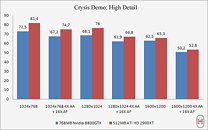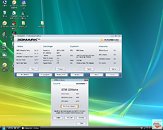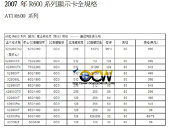
More Radeon HD2900XT benchmarks - Crysis demo and 3DMark06 again
More Radeon HD2900XT benchmarks - Crysis demo and 3DMark06 again - Update
Another day another benchmark score and this time again from a Turkish website. BilgiUstam got some results for 3DMark06 and for the first time from another application: a Crysis demo. They compared the Radeon HD2900XT to a GeForce 8800GTX on the same test platform.
Intel Core 2 Extreme QX6800
Asus P5W DH
2×1GB PC2-6400 (5-5-5-12)
Western Digital Raptor 150To sum it up: While the G80 card was faster in the theoretical benchmark 3DMark06, the R600XT outperformed the G80 card everytime by a slight margin in the Crysis tests.
Update: Here we have some more screenshots from PCINLIFE showing how the R600 card performs in 3DMark06 using 1280x1024 and 1600x1200 as resolution. This time the test platform was powered using an Intel Core 2 Duo E6600 (2x 2.40GHz) and 2GB of RAM. OS was Vista Ultimate together with the ATI Driver 8.351. The whole system managed to get 9685 3DMarks at the 1280x1024 res and 8756 3DMarks at 1600x1200. Not that bad considering the rather slow CPU.
The last shot is from the same setup now with 8x Antialiasing and 16x Anisotropic Filtering enabled. Sadly you can only guess the whole score because the first digit was painted over.
I hope that everyone who is reading this and the other news posts regarding the R600 performance numbers is judging on it with a good portion of common sense. The final cards aren't on the market and the Non Disclosure Agreement wasn't lifted yet.
Another day another benchmark score and this time again from a Turkish website. BilgiUstam got some results for 3DMark06 and for the first time from another application: a Crysis demo. They compared the Radeon HD2900XT to a GeForce 8800GTX on the same test platform.
Intel Core 2 Extreme QX6800
Asus P5W DH
2×1GB PC2-6400 (5-5-5-12)
Western Digital Raptor 150To sum it up: While the G80 card was faster in the theoretical benchmark 3DMark06, the R600XT outperformed the G80 card everytime by a slight margin in the Crysis tests.
Update: Here we have some more screenshots from PCINLIFE showing how the R600 card performs in 3DMark06 using 1280x1024 and 1600x1200 as resolution. This time the test platform was powered using an Intel Core 2 Duo E6600 (2x 2.40GHz) and 2GB of RAM. OS was Vista Ultimate together with the ATI Driver 8.351. The whole system managed to get 9685 3DMarks at the 1280x1024 res and 8756 3DMarks at 1600x1200. Not that bad considering the rather slow CPU.
The last shot is from the same setup now with 8x Antialiasing and 16x Anisotropic Filtering enabled. Sadly you can only guess the whole score because the first digit was painted over.
I hope that everyone who is reading this and the other news posts regarding the R600 performance numbers is judging on it with a good portion of common sense. The final cards aren't on the market and the Non Disclosure Agreement wasn't lifted yet.











